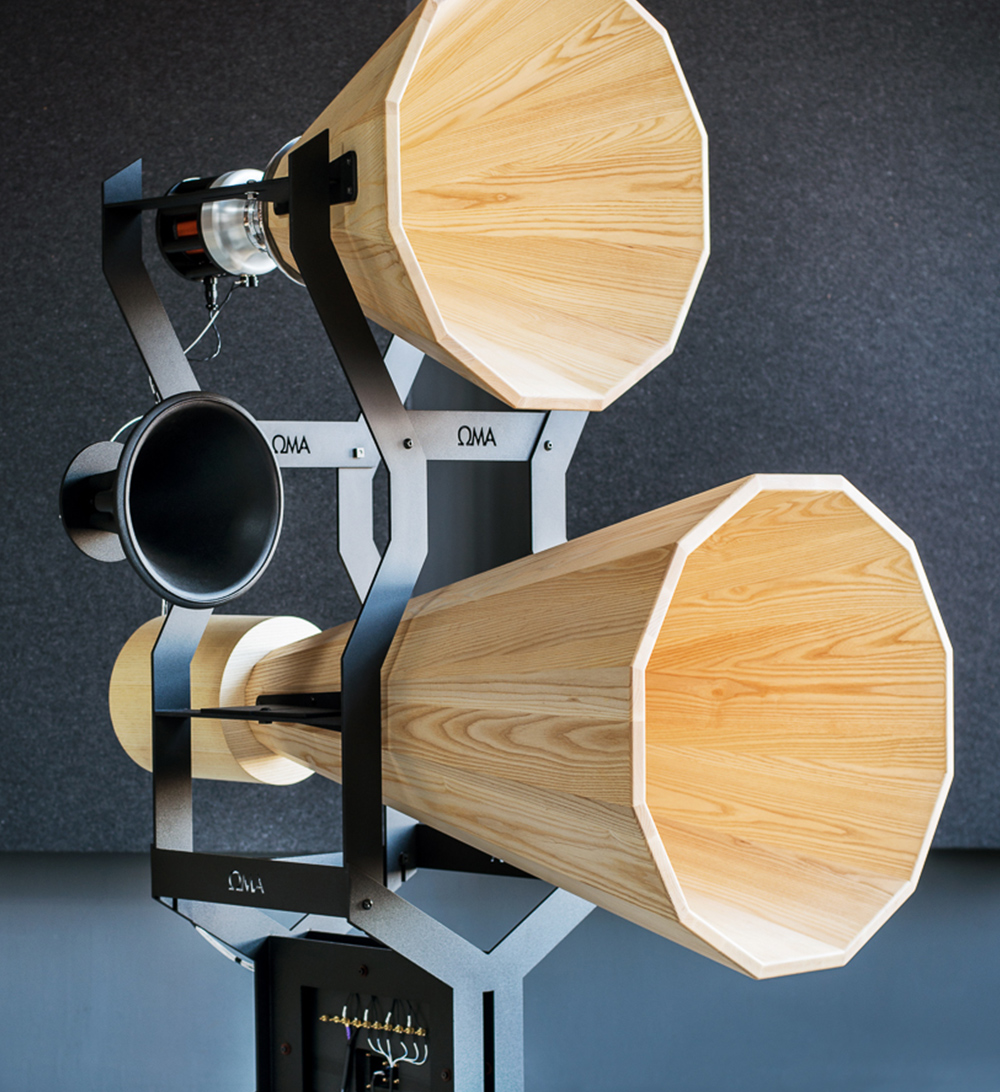loudspeakers
 Imperia
Imperia  AC1
AC1  Ironic
Ironic  Mini
Mini  Monarch
Monarch  Monitor
Monitor  Museum Speaker
Museum Speaker Design vs. Acoustics?
OMA loudspeakers are so visually striking that many people think they might be designed for visual appeal alone. But every OMA loudspeaker originates from acoustic requirements, and all answer a specific question. For example, with the Mini, we asked: "Why are there no small two-way horn speakers?" And the Imperia answered an even simpler question: "What would the world's finest speaker be like if we had no limitations?"
Why Horns?
Horn speakers in general are a breed apart from conventional loudspeakers, which radiate sound in all directions. Horn speakers are both far more efficient than conventional ones, and also directional, which means that the music is aimed where you want it, not reflected in every direction. This dramatically reduces negative room interactions, which is very important, but the overall effect is to give a sense of lifelike, natural effortlessness to the music itself. Many people who listen to OMA speakers for the first time say the same thing; they did not believe reproduced music could sound so good.
From a more technical standpoint, there are simple reasons for this. OMA is the only hifi company in the world today which relies solely on the conical profile in its horn designs. The conical profile, meaning the horn walls have straight sides, does not deform the spherical wave of sound created by the horn. All other companies use curved wall horns, which are smaller and shorter, but deform the sound wave. We prefer to have a larger horn, and better sound, and this leads to another feature of OMA speakers: their size.
Size
Technology has miniaturized most everything we use, giving us tiny mobile phones and slim computers with ever increasing power. Digital music puts an impossibly long playlist in your pocket. But sound waves cannot be made any smaller; it's just physics. Yet the trend within the audio industry to reduce the size of loudspeakers to the barest of minimums has resulted in poor, uninvolving sound which, combined with solid state amplifiers and digital music, create an experience that is hardly worth paying for. If you want music to sound like music, the size of the speakers matters. The speaker must be big enough to physically reproduce the source. A symphony orchestra or the Rolling Stones live is not going to come out of a 6 inch woofer without significant problems. We don't want to watch a movie on the tiniest TV screen, and with OMA speakers, you will understand the size and scope of music in a way impossible with conventional equipment.
Efficiency
Larger horn loaded speakers are inherently far, far more efficient than conventional ones. Almost all of the OMA line is more than 100db/1w/1m, which means that if you put just one watt of amplifier power into the speaker, you get 100db of sound pressure (a lot!) standing at one meter from the speaker. Typical high end speakers are 83-85db at 8ohms which does not sound like too big a difference, until you realize that the db scale is logarithmic- and that you need 100 times more power to make an 83db speaker play as loud as one that is 102db. In practical terms, our speakers allow the use of any amplifier, no matter how low power. Since the best amplifiers are low power triode designs, this is a huge advantage. OMA speakers use only professional drivers, not those engineered for the hifi home market, and thus can play louder than you would ever want without distortion. A useful analogy would be a car that could go 800 miles per hour. No one would be able to drive that car as fast as it could go, and the same is true with OMA speakers in a home environment. You will never push them to their limits.
Craft
All OMA products are made within a very small area of Eastern Pennsylvania, the part of the United States which gave birth to the industrial revolution and which continues to excel in small manufacturing. Our horns are cast at a local foundry, our slate comes from the last quarry in Pennsylvania, our wood is from the surrounding forests. Many of our products are entirely hand made by skilled artisans, and yet we also use cutting edge technology like five axis water jet machining.
Our Designers
Our acoustical designer Bill Woods has been designing horn loudspeakers professionally for over 35 years. He is one of a handful of the world's top experts on horns. Once Bill has set the acoustical parameters for a proposed speaker, such as the size and flare of the horn or horns, enclosure volume and geometry, selection of drivers, etc, OMA's industrial designer David D'Imperio is tasked with creating a visually arresting design that maintains it's acoustic integrity. The history of loudspeaker design shows that aesthetic beauty and acoustic excellence have rarely occurred in the same package. D'Imperio creates an individual identity for each speaker design, following from its acoustic goals.